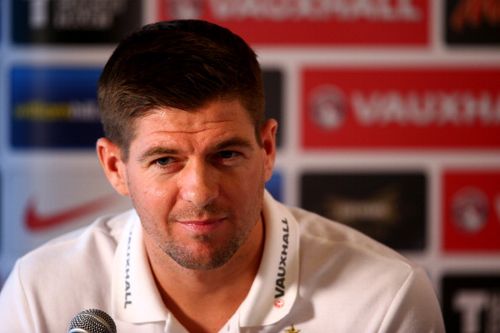
The technical Englishman

ST ALBANS, ENGLAND – OCTOBER 14: Captain Steven Gerrard of England talks to the press during a press conference following an England Training session ahead of their Group H qualifying match against Poland at London Colney on October 14, 2013 in St Albans, England. (Photo by Paul Gilham/Getty Images)
The footballing style of countries more or less remains the same over any length of time. That is more of a de facto statement rather than a proven hypothesis. There are, of course, periods of discrepancies along the timeline of history in teams’ styles; a disturbance in the force, so to speak. It has, after all, not been too long a time since Dunga’s Brazil, known more for their lack of flair than anything else, were unleashed onto the world. While the pragmatic and defensive-minded Dunga drove in the point of positional discipline, it came at the cost of Brazil losing their renowned Samba style of play. In the post-dunga period, as Mano Menezes took over, though Brazil still struggled as far as the results went, they did look to be back on the track to regain their former style of play. Now, under Luiz felipe Scolari, they seem to have rediscovered both their flair and winning nous.
With England though, their “style” over the years has been harder to define. How do you define English football? Is it a brand of football involving tough tackling midfielders with an eye for goal? Or maybe hard-working wingers who maraud down the lines to put in crosses, and track back to help the team defensively? What about burly, aerially-gifted forwards, battering opposing defenses, all the while integral also to hold the ball up for the rest of the team? The answer may be as simple as stating that it is a mixture of all of these, or it might be as complicated as saying that English football can only be defined by the players currently on the field.
One might put up the argument that the above line is true for any team; that any team’s “style” is defined by the 11 men on the pitch, joined by the glue that is the instructions of their manager. But it is also true that every team plays with the vestiges of the teams that played there before them; a ghost impression of their styles.
Spain have always been about technically-gifted players who have a penchant for passing the ball around, and a proclivity towards more narrow play, with wider players acting as “inside forwards”. Holland have been known to have swift passing, with more focus on players passing and moving into resulting space created to then form chances. Germany had the traditional, some would call it “stereotypical”, image of attacking and defending in organised manner, with a profound focus on players knowing their roles in the team, and executing them to the point. Italy are another team beset by stereotypical tags, with the Italian style of play attributed to being about an attack and a midfield that both are built about their core strength: the infamous Italian defence; not necessarily catenaccio-the door-bolt defending technique, but still an emphasis on strong defenses.
England have always defied football pundits and fans alike in their quests to categorise the team into a particular playing style. It is something that has also had a negative impact with respect to the modern version of the game. As internationally-retired Manchester United defender Rio Ferdinand had to say,
“What is our identity? I’ve said that on Twitter I don’t know how many times, and people come back and say, ‘What are you talking about?’ But what is our identity? We started to see something when Glenn Hoddle was in charge, a bit of an identity then, free-flowing football, and you would say we were starting to get an idea of the pattern of what he wanted to implement in the team. Since then I don’t think we’ve actually really seen an identity, where you could say: ‘That’s an England team,’ where you look at the Under-21s and go: ‘That’s an England team.’
“If all the names were taken off the back of the shirts and the colours were changed, you couldn’t go in there and say, ‘That’s an England team, that’s our identity, that’s the way we play.’ And that’s from the Under-16s right up to the senior team.
“Whereas you look at an Italian team, a Dutch team, a Spanish team, a German team or a Brazilian team, without seeing the names on the shirts, you would identify them because they’re working from a script. You could put an Under-16 lad into the senior Spanish team or Italian team, he might not have the attributes in terms of physique and speed to be able to deal with it but positionally I’m sure he’d know what to do because that’s what they’re taught, day in, day out.”